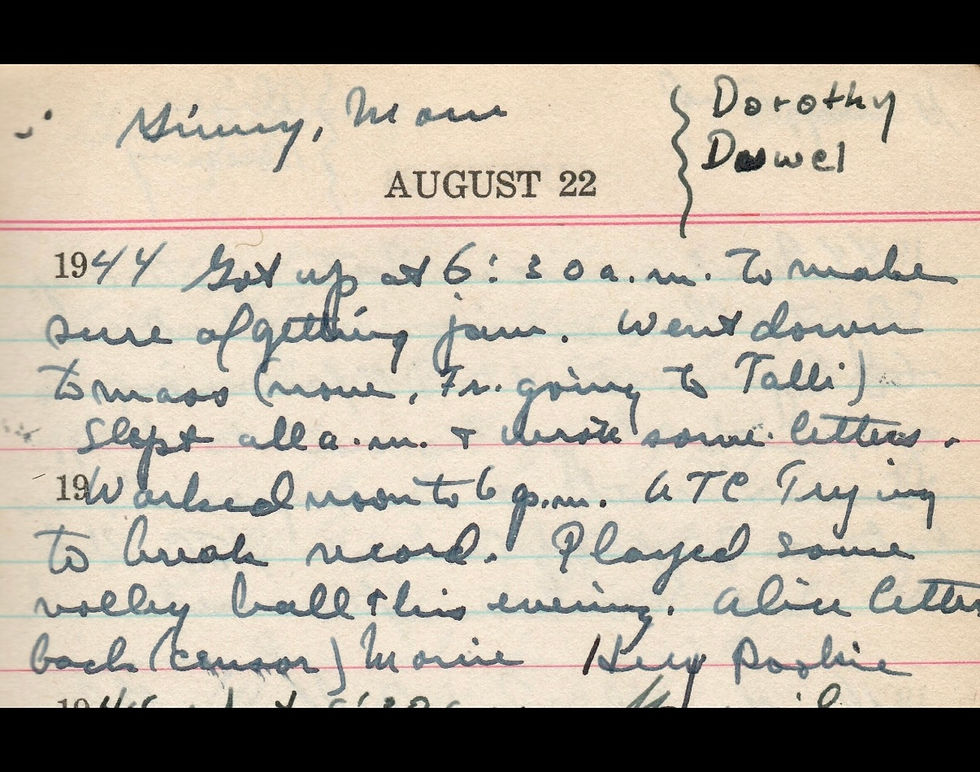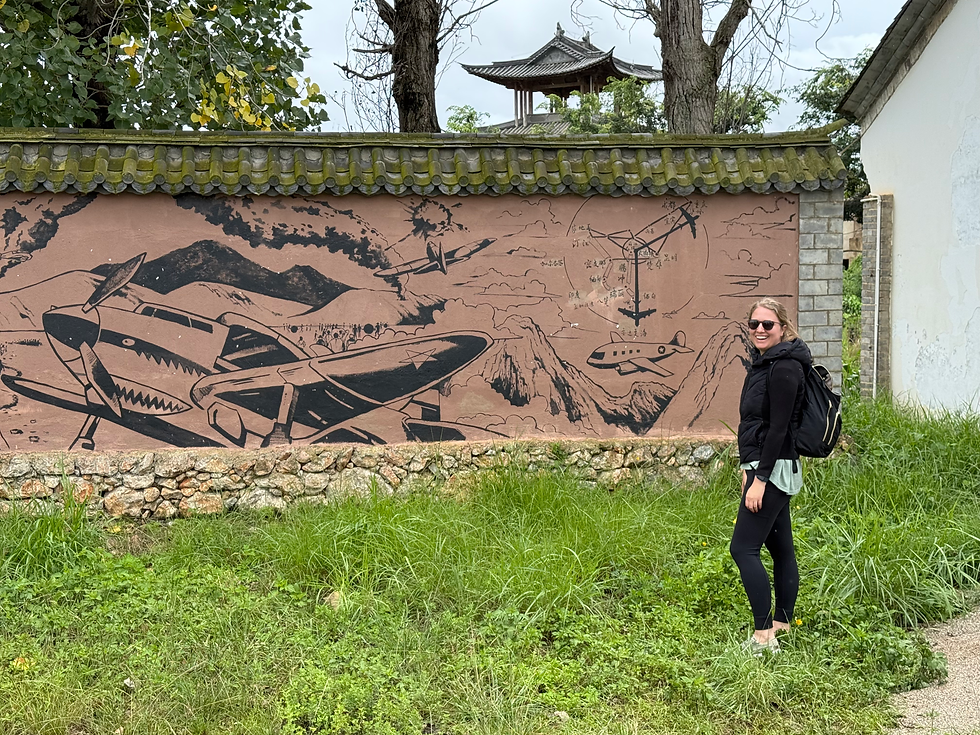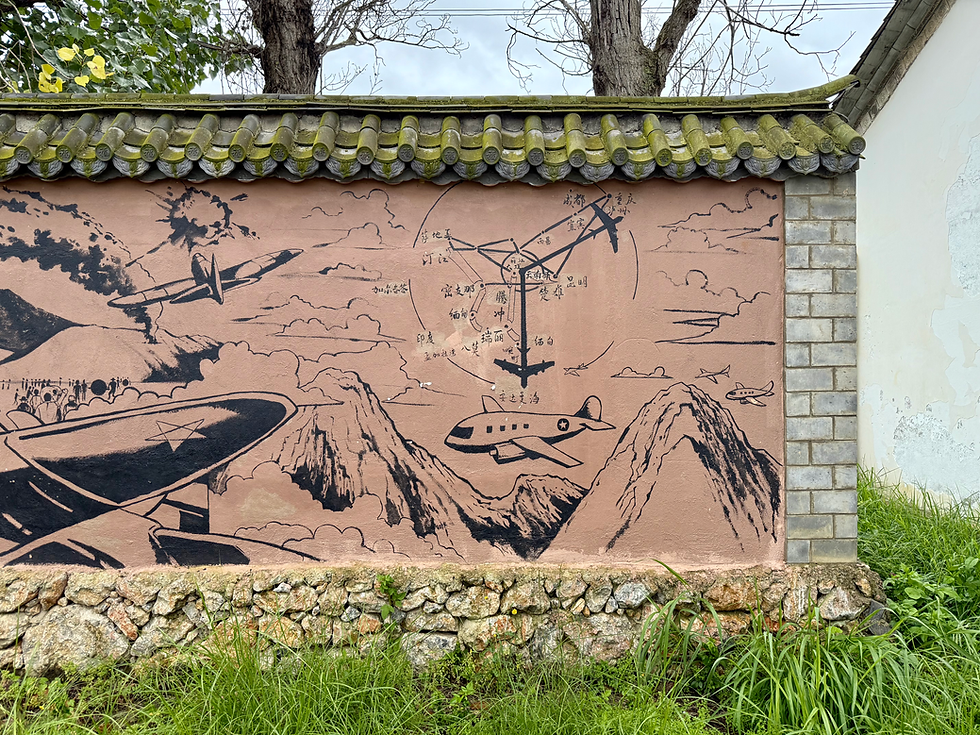Time travel across decades: Yunnanyi, China
- Sara Cavalieri

- Sep 11
- 6 min read
Updated: Sep 26
When I set out for Yunnanyi on the rainy morning of Friday, August 22, I wasn’t just visiting another small town in western China.
I was stepping into a place that holds a piece of my family’s story.

My grandfather was based in Yunnanyi during World War II, part of the Army Airways Communications Service (AACS).
I had grown up hearing fragments of his stories (only when I asked), but walking the same streets gave them an entirely different weight.
I thought I'd first start by looking back at what he was doing on August 22 in 1944 and 1945, and I found these journal entries:


I had actually passed through the region days before on the high-speed train from Kunming to Dali, and I was closely watching the map to see the location.
To my surprise, right as we passed by, the grey skies parted, and the sun broke through.
Coincidence?

Stone rollers & revetment
Though I wasn't entirely sure what would be left to see in this small, off-the-grid town, I was in for another huge surprise when we pulled over for a bathroom break.
There, right next to the restrooms, were the 500-pound stone rollers used by the local people to build the runways!

They used these massive rollers to crush the gravel that they'd broken up by hand--super impressive!
The next thing I noticed was the huge mural behind me, showing the city's storied past.




One piece of the mural was especially moving.
As my grandpa was responsible for assisting pilots with navigation, to see the coordinates here above a Hump plane was incredibly exciting.

Overcome with emotion, I didn't notice until a bit later on, but there was also a revetment and a sign with a map of the airfield!







We also found what looked to be an old foam replica of a plane's wing next to another roller.


Yunnanyi town
I brought a few of my grandpa's pictures with me, and our guide asked some of the locals if they knew where anything was located, including the old airfield.

But I instantly recognized the old road/rocks of the one street through the town.

There was never any doubt that my grandpa set foot here; the existing road has a history of more than 1,200 years.
The town dates back to the Yuan Dynasty when it was a post station.
Salt merchants and horse caravans constantly passed through.



Today, small shops line the lanes, and life carries on at a gentle pace.
The locals were curious but welcoming.
I even got to sample some of the fresh fruit for sale; the pear was unlike any other pears I've ever had!

Later in the Qing Dynasty, Yunnanyi became the most important and busiest hub for goods along the Tea Horse Ancient Road.

A museum details this tea horse history.



Nowadays, the road is still preserved and stretches a mile long.

And at the entrance, I was also over the moon excited to find another monument to General Chennault and all the people at the base.

Finally, we had lunch in a local restaurant where the owner made a delicious bowl of noodles with goat meat and all the spices we wanted.
She asked for a photo that she could use for marketing; we were the first foreigners who had ever eaten there!
I told her I hoped the photo would bring her much business.
The Sino-India-Burma Theater Transportation History Museum
And then, yet another delight; a museum dedicated to the Yunnanyi Airfield and Hump operations is still thriving.

Though most of the information is in Chinese, it was fascinating to see old photos and U.S. Army Air Force items, including one of the phones!

It was weird to think that my grandpa, who worked in communications, may have used this very piece--or if nothing else, perhaps his voice came through this very line.
A model-size replica of the airfield also gave me a great perspective on how close the field was to the town.

And on the wall, another memorial to one of Yunnanyi's fighter pilots who gave his life--1st Lt. Robert Mooney.

For more information about the monument that the locals built for Mooney in the nearby hills, check out this post.
My grandpa always said his favorite part about being here was playing with the kids though, so I found it perfectly fitting that two playful little girls starting following us around town, first to the Tea Horse Museum and then to this one.


Every time we smiled their way, they went running to hide.
But by the time we reached this museum, they had become more brave, and they liked taking photos and learning some English words.
We were the first foreigners they had ever seen, too.



Old Yunnanyi Airfield
Actually, there were two airfields in this area during World War II.
The original one is about a mile away from the new one, along the Burma Road, and was home to pilots from the American Volunteer Group (AVG)--later known as the Flying Tigers.

My grandpa started at the newer one before they eventually set up a more modern Direction Finder (SCR-291) out at the old AVG field.
Before coming on this trip, I learned that the Chinese military had taken over the old AVG field, so I knew I wouldn't be able to see it.
But I also heard there wasn't much left of the newer, larger field--only that farmers had grown their crops over it.
However, talking to one of the locals, we were told to "follow the Burma Road to the second eucalyptus tree"--and we'd find it.
Turns out we accidentally stopped at the first eucalyptus tree, which was next to a sunflower field.
The locals working in it told us we had to go a bit farther.
On to the next eucalyptus!

Sure enough, at the second eucalyptus tree, there it was.
And it came unexpectedly with a sign and all!

We spent the next 20 minutes or so looking at my grandpa's old photos and files, searching for some of the same mountains.

I also brought a picture of the propaganda flyer (which is on my desk at home) that the Japanese dropped on Yunnanyi during their raid of November 28, 1944.

And then, after all the photos were done, I took some time to just think.

I don't really remember what I was thinking, besides the fact that it was so eerily quiet.

It's still mind-blowing to me that a war could take place in such a peaceful spot--and that the people we sent there were so young.
My grandpa was 19 when he arrived.

Reflections
It is difficult to put into words how much it meant for me to finally visit this place; it was definitely a life dream achieved--particularly given the book I'm writing based on my grandpa's story, which is set in Yunnanyi.
The only way this visit would have been better is if my parents had come as planned, too, but due to a health emergency, they had to cancel last minute.

Still, I couldn't miss this opportunity, and I do hope to go back.
But what I can say is that Friday, August 22, 2025, started out as a rainy day.
A rainy day--until we arrived in Yunnanyi.
Just like when I passed by on the train from Kunming to Dali, the sun seemed to come out over Yunnanyi once again--just for me.
And it stayed that way for the rest of the day.

I like to think it was my grandpa's way of saying hello--that it was his way of telling me he knew I was there.
His way of telling me he was happy.



















































Comments